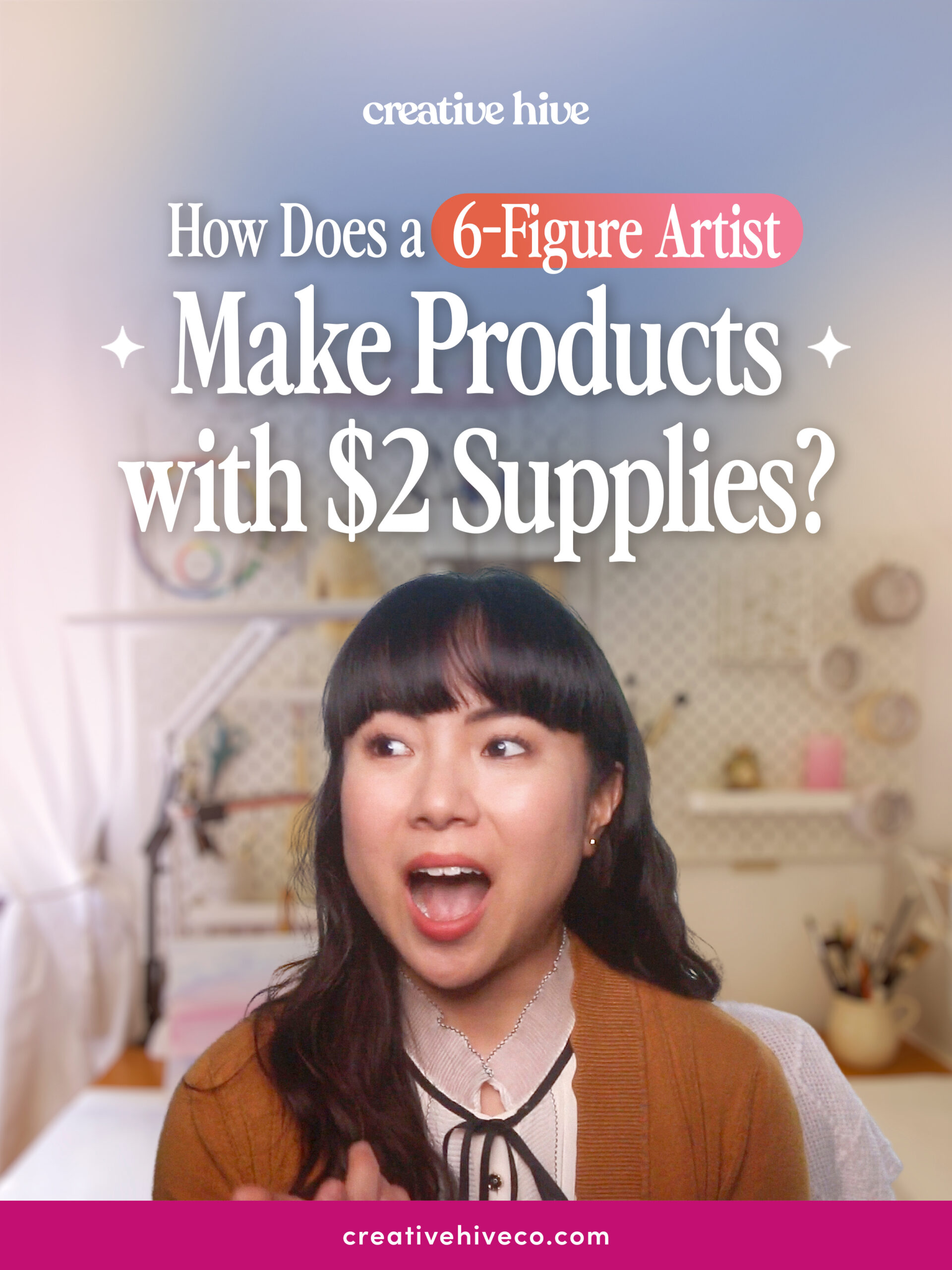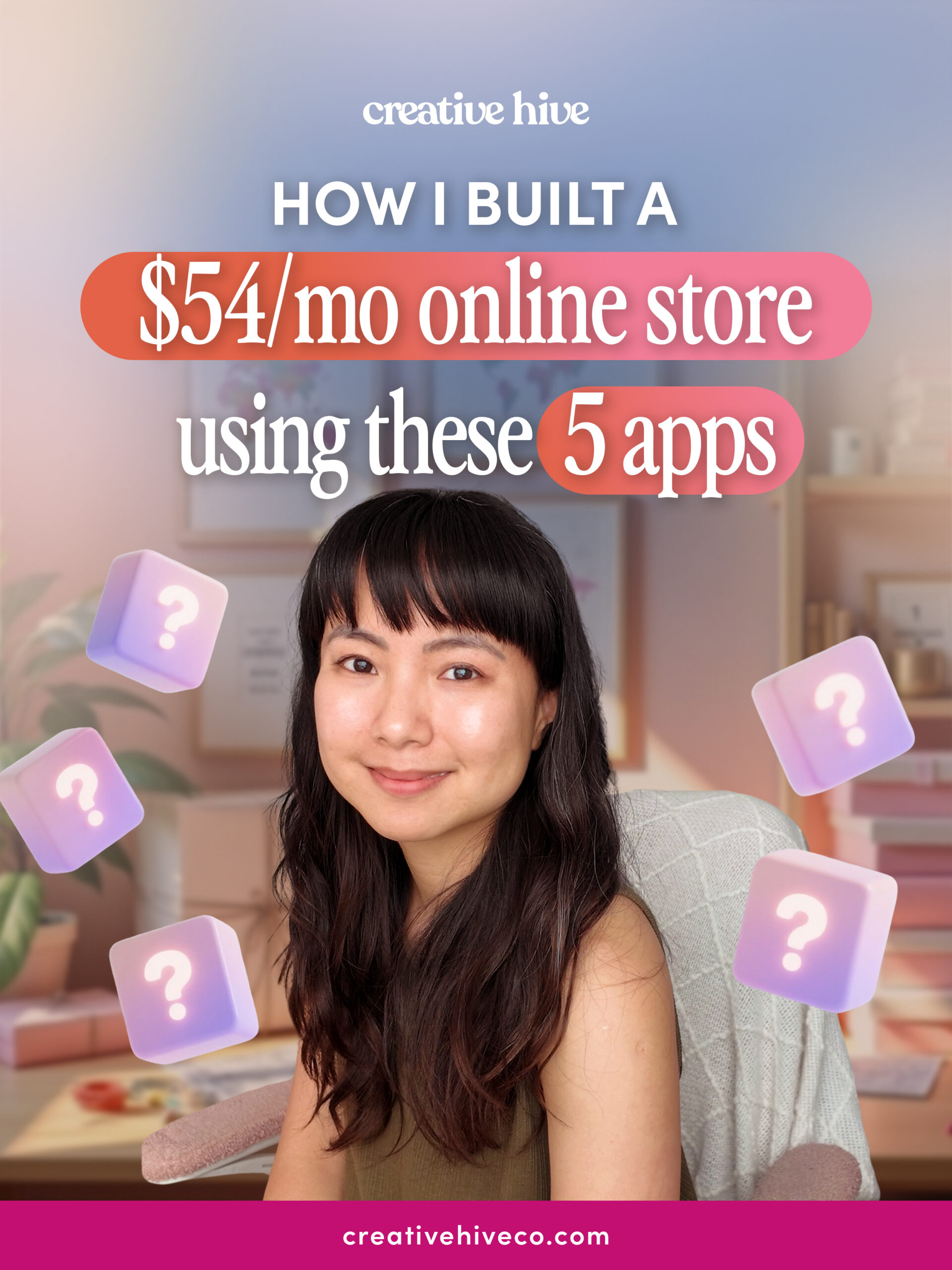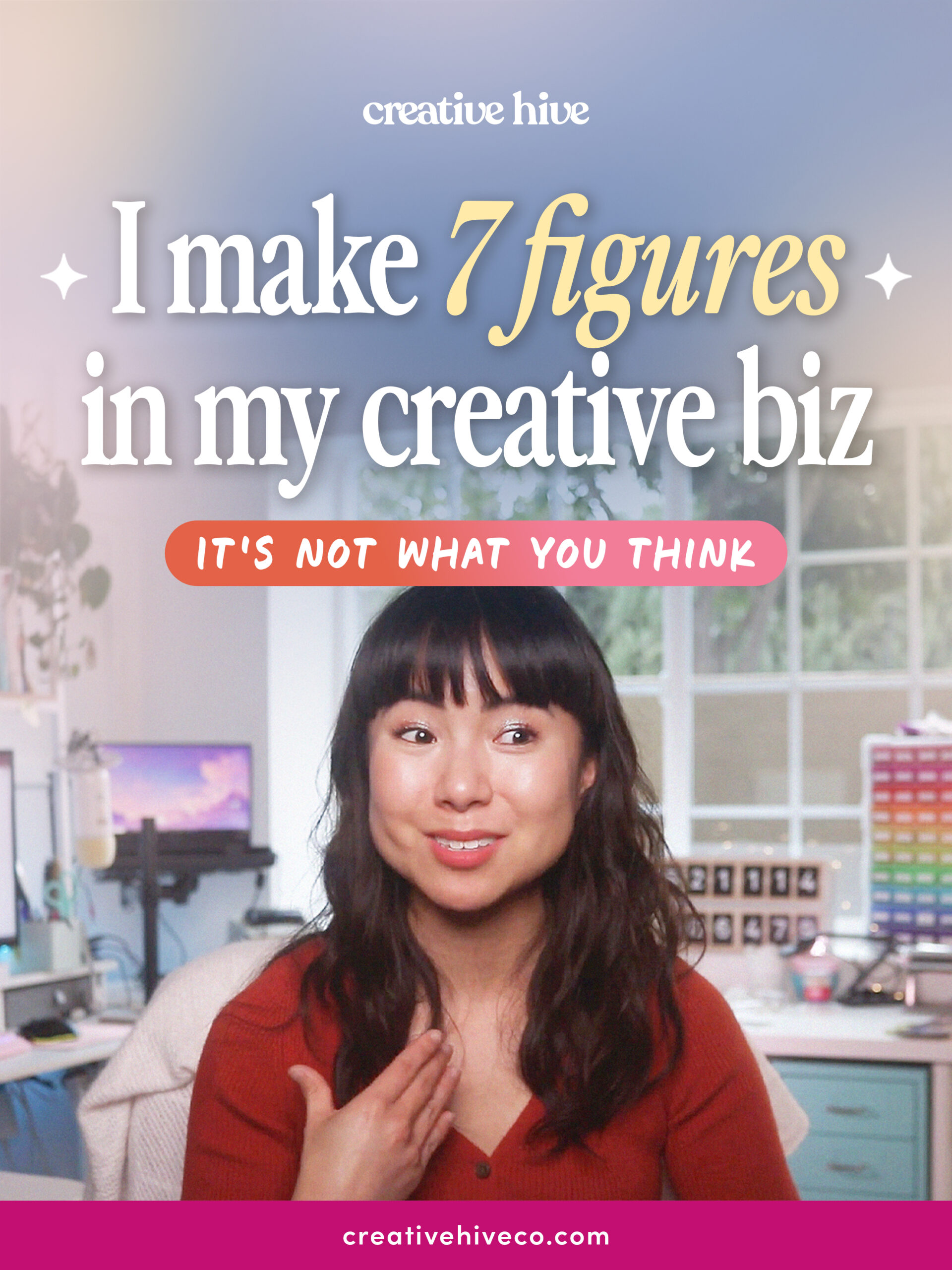How Does a 6-Figure Artist Make Products with $2 Supplies?
I want to help you build a sustainable, profitable handmade business that makes you consistent income and sales. I only ever teach or recommend marketing, social media, pricing, production and branding tips that I’ve personally used successfully in my own 7-figure handmade businesses.
I'm Mei, from Los Angeles!
Read More
Popular Posts You'll Love
Looking for something?
Categories
starting a business
get more traffic
running a business
make more sales
branding
growing a business
mindset & productivity
podcasts
pricing & money
product photography
reviews
selling on etsy
selling on amazon
social media
selling wholesale
- Facebook0
- Twitter0
- Pinterest0
- 0shares
If you’re running a handmade business and think you need expensive materials to charge higher prices, we need to talk.
I’m about to show you why that idea doesn’t work and what to do instead.
I use a counterintuitive process that has helped me build multiple six- and seven-figure businesses. And here’s the crazy part: the products I sell cost me less than $2 in materials to make.
Yep, under $2.
And my customers? They happily pay between $30 and $100 for these products and they keep coming back for more.
This isn’t a fluke or some once-in-a-lifetime luck.
It’s a real, repeatable business strategy that focuses on what actually matters to customers, not the things most handmade sellers obsess over.
If you’re pouring money into supplies hoping it’ll magically lead to more sales, it’s time for a serious shift.
And that starts with avoiding the 3 most common product mistakes I see handmade sellers make all the time. Let’s start with the first one:

Mistake #1: The Misconception About Materials
Let’s talk about something that most handmade artists really don’t want to hear:
The materials you use? They matter way less than you think.
I know, that might sound crazy. Especially when you’re pouring your heart (and half your paycheck) into buying the perfect supplies.
In this blog, I’m about to tell you what actually matters to customers, and how focusing on the right things changed everything for me.
I started my first business, Tiny Hands, in 2006. I was making scented polymer clay food jewelry, tiny little cupcakes, waffles, and macarons you could actually smell!
Fast forward a bit: Tiny Hands got featured on Parks and Recreation, in dozens of magazines, and has sold over 100,000 pieces around the world.
Since then, I’ve built multiple seven-figure businesses including a personalized map art shop I started with my husband. That little side project? It made over a million dollars in its first year.
And today, I even have a third jewelry shop that brings in sales week after week without me doing any marketing at all.
The products practically sell themselves, no ads, no constant posting, no hustle.
If you stick by the end of this blog, I’ll show you the exact process I use to research high-demand products, so you can start creating things people actually want to buy.
But first, let’s rewind a little. When I first started Tiny Hands, I was obsessed with the craft.
I spent hours figuring out how to make the tiniest details look just right. I learned how to use liquid clay to make cupcake frosting that looked so real, you’d swear you could eat it.
And every time I finally got two tricky materials to work together? It felt like winning a gold medal.
As artists, we live for those moments, right? The thrill of making something beautiful with your own two hands.
I was so proud of myself and the work I was putting out.
Every tiny detail of my miniatures got special care and attention.
I spent weeks designing each new piece, usually two to four weeks just testing color combos, playing around with different textures, and even experimenting with scents.
And along with that creative obsession came a major obsession with my supplies.
I was always on the hunt for the “best” materials, the best paper, the best ink, the best boxes, the best necklace chains.
If there was a new supply that promised better quality, I had to have it.
I even splurged on custom printed boxes with my brand and logo on them.
They were crazy expensive and a total pain to assemble you had to hot glue the sides together one by one.
But I didn’t care. Even though I was a broke college student at the time, I fully believed that using the best materials would automatically mean I was creating the best products.
So I kept pouring all my money into supplies… and ended up with nothing left over to actually drive traffic to my shop.
In the early years of building my shop, I came up with a tagline that I thought sounded really professional:
“Expertly crafted and customizable scented food jewelry.”
Sounds fancy, right?
The problem was… I struggled to make sales for years under that tagline.
Looking back, it’s so obvious why. That whole “expertly crafted” vibe wasn’t just in the words, it bled into everything I did, from my marketing to how I talked about my products.
It was all about me as the artist.
My skills.
My expertise.
My process.
And honestly? It’s a little cringey now to think about it. But it also shows just how little I understood about business back then.
That tagline? It was completely ego-driven. I was talking about myself, not about what my customers actually cared about.
I forgot the most important rule of selling: I’m not the customer. The customer is the customer.
Today, my tagline is a whole lot simpler: “Super cute scented food jewelry.”
That’s it. And you know what? “Super cute” are the exact words my customers constantly use when they see and experience my jewelry.
This shift, from focusing on myself to focusing on what they cared about marked the moment my business finally started taking off.
Here’s the big takeaway: Customers don’t buy your products because of the materials you use.
They buy because of how your product looks. Because of what it represents. Because of how it makes them feel.
They’re purchasing the experience and the outcome not your process or a list of fancy materials.
These days, I do things very differently.
Instead of splurging on custom printed boxes that were crazy expensive and a nightmare to put together, I now use custom printed hang tags.
They’re way cheaper and we just pop them into standard gift boxes. Easy, affordable, and still super cute.
Instead of using sterling silver necklace chains which could easily cost $20 each I use silver-plated chains made with new vacuum plating technology.
It makes the plating thicker and way more tarnish-resistant, so it still looks amazing for years… and it costs me less than a dollar per chain.
And instead of obsessing over my process in my marketing, I shifted my focus completely to the end product and how it makes my customers feel.
That shift in thinking changed everything for me.
I stopped asking questions like, “What’s the fanciest supply I can use?” or “What cool technique can I show off?”
Instead, I started asking: “What finished product would make my customer excited to receive it?”
That customer-first mindset is what creates products that actually sell over and over again.
Of course, this was just one piece of the bigger puzzle that helped me grow from barely making sales to hitting six figures year after year.
And if you’re dreaming of that for your own shop? I’ve got something that can help.
I teach a free workshop where I break down the exact system I use, the same system that’s helped other artists quit their jobs, retire their spouses, multiply their income, and even sell their businesses.
If you’re interested, you can sign up for free here: https://tinyurl.com/papfm8ev
Mistake #2: Assuming Customers Think Like You
The second big mistake I see artists make is assuming that customers value the same things we do.
As creators, we get caught up obsessing over material quality, perfect execution, tiny craftsmanship details…
But here’s the truth: Most customers don’t even notice 90% of what you’re stressing over.
And more importantly, they’re not willing to pay extra for it, because it’s just not important to them.
They don’t care how many hours it took you to make something. They’re not thinking about the process.
Unless they’re artists themselves, most customers are everyday people. They have no idea what goes on behind the scenes, and they definitely don’t know (or care) about all the fancy materials you used.
I learned this lesson the hard way one night while making a batch of chocolate chip cookie charms.
Back then, I still made all my charms by hand (these days, I have a team of production assistants who help me).
I was on a tight deadline trying to get a bunch of orders out.
I was exhausted and spending way too much time meticulously placing every tiny chocolate chip into each cookie.
And it wasn’t just tossing them into the clay. Each chip had to be perfectly lodged in so it wouldn’t fall out later.
But if you weren’t careful, you could smear the brown coloring, which meant even more touch-ups and even more time.
It was so much work for something that… honestly? Barely anyone would even notice.
At that time, I made sure the front and back of every cookie charm had chocolate chips.
Yep, even the back, the part no one would really see when wearing the necklace.
And that night, in my tired, stressed-out state, I thought: What if I just… didn’t? What if I skipped putting chips on the back and only focused on the front?
It would save me so much time. So I decided to experiment.
I finished the batch with no chips on the back, sent the orders out, and waited to see if anyone said anything.
I’ll admit, I was nervous. I thought maybe I was being lazy, and I worried my customers would be upset with me for cutting corners. But honestly, I just really wanted to sleep that night.
So, what happened?
None of my customers complained. In fact, they all sent back glowing reviews about how cute the cookie charms were.
That moment taught me a crucial lesson: Invest your time and resources where customers actually perceive value, not where you think they should.
Now, I run my polymer clay jewelry business with that lesson in mind.
Instead of spending hours adding intricate details and unnecessary frills that customers likely won’t even notice, I focus on creating simple yet effective designs.
I could easily dive into the world of hyper-realistic food charms, making every tiny detail perfect, but that’s just not practical for me. It takes too much time and doesn’t make sense commercially.
Take my waffle necklace, for example. It has tiny butter pats, glossy maple syrup, and the right colors to capture the essence of a waffle.
But it’s not an exact replica of a waffle, and it’s certainly not the most detailed one out there.
The key? It still looks adorable as a piece of jewelry. And that’s what matters most.
I completely transformed how I market my products.
Instead of focusing on things like “premium quality materials” or “handmade with love,” I started highlighting the emotional benefits of my jewelry.
I used to talk about how much time went into creating my pieces, but no one outside of my mom cares about that.
I now talk about “wearable nostalgia”, how my jewelry are great conversation starters, how they make great gifts and always bring a smile to a little girl’s face.
Each necklace costs me around $2 to make, including materials and labor.
But customers are happy to pay $30-$50 because I focus on what they actually value.
I’m not cutting corners. Product quality and durability still matter.
But the real difference comes from creating an experience my customers love.
It’s all about being smart with time, money, and energy to give them what they want, not just what I think they need.

Mistake #3: Skipping Market Research
The third principle and where serious money is made is using market research.
This guides your product development instead of just relying on your artistic intuition.
Most artists skip this step because they think their creativity is enough, and if they build it, customers will come, right?
Not anymore.
Today, understanding what already sells and finding opportunities to stand out is what separates shops that make inconsistent sales from those that bring in a full-time income.
This principle became the foundation of the most successful business I’ve built.
In 2019, my husband and I launched a personalized map art business.
But before we even thought about creating a product, we spent two weeks researching what was already out there.
And here’s what we found: Every single map art seller was using almost the exact same dark blue backgrounds or simple black-and-white designs.
They all looked the same! No one was standing out in a meaningful way.
After doing all that research, we decided to go bold with our art.
I’ve always had a thing for color, bright colors just make me happy, you know?
So we designed our map art using a more vibrant palette. And here’s the kicker: we didn’t go overboard with expensive custom printing or premium framing.
Instead, we used standard print-on-demand services that cost just a few bucks per print.
It wasn’t about using fancy paper or creating some heirloom piece of art.
Our goal was simple: to create something that was accessible, personalized, and that most people could actually afford and enjoy.
And guess what? That strategy paid off big time.
Our business raked in over a million dollars in its first year alone.
Now, don’t get me wrong, we’re not skimping on quality, but we also didn’t go all out with pricey materials like museum-quality frames or ultra-specialty paper.
Instead, we focused on making our product different and unique in a way that mattered to our customers.
For the framed prints, we spent a modest $20 per piece, using supplies that were “good enough” but still satisfied most of our customers because they loved what made our art stand out from everything else out there.
So, yeah, it’s not about throwing money at premium materials, it’s about making your product meaningfully different and giving customers something they can’t find anywhere else.
Steps to do Market Research
Now, to help you do that, here’s my exact market research process that helped me create multiple winning products across different businesses. And the good news is you don’t need any of those fancy research software. Just use Google, it’s free.
1. Find at least 8-10 other successful shops selling products similar to what you want to make. Don’t just look at the top 2-3 results, dig deeper to see the full range of what’s out there.
2. Analyze their pricing. What’s the price range people are willing to pay? Look for the ceiling price. This shows the potential for how much people are willing to pay and gives insight into the perceived value of that type of product.
3. Read customer reviews carefully. What do customers consistently love? What are they wishing was different or better? Pay attention to patterns in feedback.
4. Identify what ALL the existing shops have in common. This is your opportunity to stand out. What’s the “standard”? Now, think about how you can add your unique twist to this.
Let me share a few examples of how this process has played out in my own businesses:
When I first started making my food jewelry, I noticed that all my competitors were obsessed with creating hyper-realistic designs.
But instead of following that trend, I decided to take a different route.
I focused on simpler, cuter renditions of food instead.
And here’s the fun part: I added scents to my charms.
That little twist made my products stand out, and my customers absolutely loved it.
It was a unique touch that brought a smile to their faces and made the buying experience more fun!
For my map art shop, competitors all used the same colors. My opportunity was adding brighter colors to them.
This was my opportunity to stand out and it paid off big time.
In my coaching business, I saw that most coaches were focusing on selling through Etsy or primarily using social media to market their products.
But I chose a different approach.
I decided to focus on media outreach marketing and getting products featured in front of other people’s audiences, rather than slowly building your own following one person at a time.
This strategy has been not only faster but more effective, with results that have lasted much longer.
The key takeaway here is that standing out in any industry isn’t about being different just for the sake of it. It’s about being different in ways that matter to your customers.
For my food jewelry, I added scents when everyone else was only focused on appearance.
For my map art, I designed them in a way that appealed to people who also love color, because the existing options at the time were very limiting.
I spend time reading customer reviews of my competitors’ products to understand what people love, what they wish was different, and what they want more of.
I look for patterns in their feedback, and this gives me so much valuable data about what customers actually care about and where there are opportunities for me to step in with my own products.
A Sale A Day
If you’re looking for a step-by-step guide with examples, walkthroughs, and a deeper dive into my exact process for finding profitable product ideas and building a business that generates sales every single day, then you’re in the right place!
I teach all of this inside my program, A Sale A Day Business System.
And if you’re not ready to commit yet, don’t worry, I also have a free workshop that talks about all this in more detail, just click here: https://tinyurl.com/papfm8ev
If you want to start using the strategies to create products that stand out and attract consistent sales, remember, it’s all about being smart with your research and finding the gaps your customers need you to fill.
What makes it even sweeter? It costs absolutely nothing but a little time and attention.

Leave a Comment
Liked this article? Share it!
Unlock a Profitable Handmade Business
in Just 12 Weeks Without Using Etsy
or Social Media
FREE WORKSHOP
This workshop is for anyone who makes and sells a handmade or physical product, including jewelry designers, artists, paper designers, bath & body product makers and more!
What You'll Discover
The #1 mistake people make with Etsy & social media that causes shops to FLOP
The secret to making it with your handmade shop so it's no longer just a hobby
How to make sales in your handmade shop with ease so you can finally get to 6-figures
TAKE ME THERE
Your email address will not be published. Required fields are marked *
Leave a Reply Cancel reply
About
Blog
A Sale A Day
Student Login
Free Class
Contact
Terms
Become A Student
Watch On YouTube
Student Reviews
See My Handmade Shop!



This is useful article for us. Thanks for share it.
Regards
Ryan
It’s so exciting for me as a mom and wife, to understand better that is possible to have balance in everything I create. In how I use my time, money and energy. I am an artist and I truly love ❤️ what I do, as well as details. But balance and the right strategies are the key right..
This post is quite good and beneficial. You and everyone else are doing a great job, and I appreciate it.
Hey, you! Mastering your MyCardStatement login is a game-changer—I’ve been hooked since it turned my financial chaos into control. I’ll walk you through why it’s worth it: we’ve covered troubleshooting login hiccups, beefing up account security, unlocking cardholder benefits, digging into online portal features, prepping for your first login, nailing basic access, making payments a breeze, and snagging rewards.